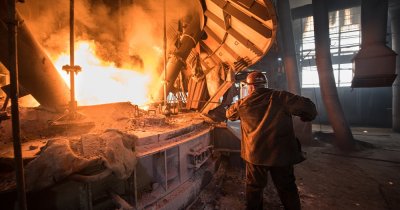With a lifespan in the atmosphere of as much as two decades, methane has the ability to heat the planet up to 80 times more compared to CO2 emissions.
According to Politico, the Danish military forces reported that methane is escaping into the Baltic Sea in three different spots, one of them being a kilometer across.
The German sources say that "it can be assumed that it’s a large amount", as both pipelines were functional.
Despite the fact that gas deliveries were halted a month ago, estimates show that the amount of methane leaking can be ranging anywhere from 150 million to 500 million cubic meters.
Kristoffer Böttzauw, the director of the Danish Energy Agency, said that the leaked methane emissions would be the equivalent of some 14 million tons of CO2, or 32% of the country's annual emissions.
On the other hand, Germany's Federal Environment Agency estimated the leaks at an equivalent of around 7.2 million tons of CO2 or 1% of Germany's annual emissions.
Agency officials also warned that there are no sealing mechanisms across the pipelines, meaning that "in all likelihood the entire contents of the pipes will escape."
Experts also say that out of all the methane that will leave the pipelines, some of it will be absorbed by sea bacteria, meaning that not all of it will reach the atmosphere.
"Not the climate disaster one might think"
Comparatively, one of the largest methane leaks in history was recorded in the US during the 2015 Aliso Canyon leak, when 90.000 tons of methane were released in the atmosphere over a few months.
David McCabe, a senior scientist with the Clean Air Task Force, says that the current leakage happening in Europe, which could release twice that amount, might be an "unprecedented" disaster.

According to Jeffrey Kargel, senior scientist at the Planetary Research Institute in Tucson, Arizona, "the amount of gas lost from the pipeline obviously is large. But it is not the climate disaster one might think."
Considering that the annual carbon emissions are evaluated at some 32 billion tons, this leak would represent a fairly small amount of that and it's not much even when compared to the massive methane releases coming from the industrial and farming sectors.
Dave Reay, executive director of the Edinburgh Climate Change Institute, added that "this is a wee bubble in the ocean compared to the huge amounts of so-called fugitive methane that are emitted every day around the world due to things like fracking, coal mining and oil extraction."
As far as the local environment goes, the immediate vicinity of the areas where methane leaks are considered dangerous places.
Any concentration of methane higher than 5% means represents a high risk of an explosion and while not a toxic gas, high concentrations reduce the available quantity of oxygen.
Shipping has also been restricted within a five nautical miles range of the leaks, as the methane can affect a ship's ability to float, causing damage to its hull.
While long-term effects on the local environment are not expected, creatures with poorer swimming abilities, such as jellyfish, might be unfortunately killed.
Lauri Myllyvirta, lead analyst at the Center for Research on Energy and Clean Air, added that "from our current understanding, I would think that the local effects on marine life in the area is rather small."
Possible solutions
Some authorities have suggested that the remaining methane should be pumped out, but experts say that this is not possible, and once all methane will leave the pipelines, they will be filled with water.
"At the moment, no one can go underwater — the danger is too great due to the escaping methane", officials say, but repairs will be the responsibility of Nord Stream AG, the owners of the pipeline.
Burning methane can be another solution, which is actually practiced around the world, as this reduces the gas' power to heat the planet by anywhere from 30 to 80 times.
But air pollution coming from the said combustion could pose a threat for the locals and no government made it clear that this is a considered option.
The Danish Energy Agency director stated that "we expect that gas will flow out of the pipes until the end of the week."
"After that, first of all, from the Danish side, we will try to get out and investigate what the cause is, and approach the pipes, so that we can have it investigated properly. We can do that when the gas leak has stopped", he concluded.
 Mihai - Cristian Ioniță
Mihai - Cristian Ioniță












Any thoughts?